Marcus Sedgwick's Blog, page 5
July 5, 2013
Four people I met in Chicago
This is the third of three posts about my recent trip to Chicago, and this one is about four very cool artists I met there, and the very cool books that they make. These people are well-known names in the US, but might not be so familiar in the UK. If you can get hold of their books, you won't be disappointed.
First up is Gene Luen Yang. I'd list every award that Gene has won but that would use up this whole post, suffice to say that one of his previous books; American Born Chinese, was the first graphic novel to win the incredibly prestigious Printz Award.
Here's his latest project: Boxers and Saints:
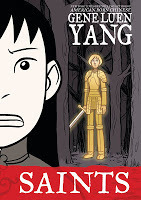
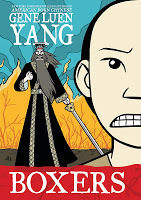
It's such a simple but brilliant idea; while reading about the Boxer rebellion that happened in China at the end of the 19th Century, he found himself unable to decide which side he felt more sympathy with; the result therefore is not one but two books on the subject. The genius of this is obvious; all stories have two sides, but history is very good at sometimes forgetting one of them. Not so with Boxers and Saints, and the result is very powerful stuff that I suspect will win Gene more awards.
Second, here's a couple of books by Faith Erin Hicks, a Canadian illustrator with a wonderful modern edge to her work.
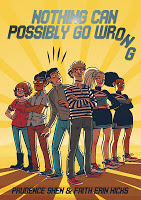
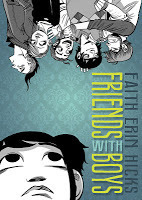
I should point out that Nothing Can Possibly Go Wrong was written by Prudence Sen. Faith explained to me how the book was serialised online, for free, before publication as a physical book. It's an interesting approach and one that might worry some authors, but Faith reckons it's a model that has worked well and has helped build her reputation since her previous book; Friends with Boys.
Third up is the 'rock star of graphic novels' (as he was described to me): Paul Pope. Paul is certainly a very cool gentleman; it was enough to learn that he lives in Brooklyn, knows Thurston Moore, and that his girlfriend is a trapeze artist to realise the truth of that introduction.
Paul's clients include LucasArts, Paramount, Diesel, DKNY, Dargaud, Marvel, DC... the list is seemingly endless.
He was a charming guy to hang out with, and always had something interesting to say whatever we were talking about. He also disproves that widely-held belief that the biggest names have the biggest egos - his modesty was extremely refreshing. Here's the cover of his latest book; Battling Boy. It simply bursts with energy, and I loved it.
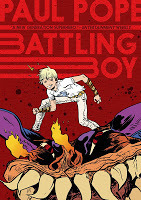
Now, the final artist of these fantastic four: Mark Siegel, and his extraordinary work; Sailor Twain.
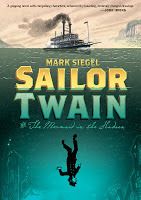
I can't do this book justice in a few words; let me just say that it's beautiful, funny, touching, exciting, dark and sexy, and not for nothing did the book become a New York Times bestseller. Mark's soft charcoals give a lovely mysterious edge to this tale of a steamboat captain who becomes entranced by a wounded mermaid he takes into his care. It's just wonderful and here to give you a flavour is the full page splash when Twain finds the mermaid on the deck of his boat.
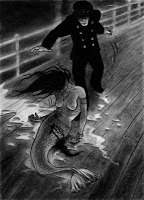
Isn't that the most beautiful thing you've seen in a while?
So there's four wonderful and very different artists who it was my very great pleasure to meet in the States, and I hope you find something to love there too.
First up is Gene Luen Yang. I'd list every award that Gene has won but that would use up this whole post, suffice to say that one of his previous books; American Born Chinese, was the first graphic novel to win the incredibly prestigious Printz Award.
Here's his latest project: Boxers and Saints:


It's such a simple but brilliant idea; while reading about the Boxer rebellion that happened in China at the end of the 19th Century, he found himself unable to decide which side he felt more sympathy with; the result therefore is not one but two books on the subject. The genius of this is obvious; all stories have two sides, but history is very good at sometimes forgetting one of them. Not so with Boxers and Saints, and the result is very powerful stuff that I suspect will win Gene more awards.
Second, here's a couple of books by Faith Erin Hicks, a Canadian illustrator with a wonderful modern edge to her work.


I should point out that Nothing Can Possibly Go Wrong was written by Prudence Sen. Faith explained to me how the book was serialised online, for free, before publication as a physical book. It's an interesting approach and one that might worry some authors, but Faith reckons it's a model that has worked well and has helped build her reputation since her previous book; Friends with Boys.
Third up is the 'rock star of graphic novels' (as he was described to me): Paul Pope. Paul is certainly a very cool gentleman; it was enough to learn that he lives in Brooklyn, knows Thurston Moore, and that his girlfriend is a trapeze artist to realise the truth of that introduction.
Paul's clients include LucasArts, Paramount, Diesel, DKNY, Dargaud, Marvel, DC... the list is seemingly endless.
He was a charming guy to hang out with, and always had something interesting to say whatever we were talking about. He also disproves that widely-held belief that the biggest names have the biggest egos - his modesty was extremely refreshing. Here's the cover of his latest book; Battling Boy. It simply bursts with energy, and I loved it.

Now, the final artist of these fantastic four: Mark Siegel, and his extraordinary work; Sailor Twain.

I can't do this book justice in a few words; let me just say that it's beautiful, funny, touching, exciting, dark and sexy, and not for nothing did the book become a New York Times bestseller. Mark's soft charcoals give a lovely mysterious edge to this tale of a steamboat captain who becomes entranced by a wounded mermaid he takes into his care. It's just wonderful and here to give you a flavour is the full page splash when Twain finds the mermaid on the deck of his boat.

Isn't that the most beautiful thing you've seen in a while?
So there's four wonderful and very different artists who it was my very great pleasure to meet in the States, and I hope you find something to love there too.
Published on July 05, 2013 05:08
July 1, 2013
Goodbye Chicago ALA 2013
I just finished my second ALA - this time in Chicago. The American Library Association annual conference is an extraordinary thing to visit - the vast scale of it alone makes it unlike anything we have in the UK.
Here's the view across the exhibition hall:

Yes, it's big. The other thing that strikes you immediately is how enthusiastic, knowledgable and passionate the delegates are. Whether they're from school or public libraries, I lost count of the great conversations I had with people over the importance of libraries, their changing role, and the sheer joy of helping children become more confident readers. In this respect, that's very like things are at home in the UK - we have passionate librarians too, but the sheer size of this conference and therefore the combined 'love in the room' is delightfully overwhelming.
I did a few events over the weekend. Here's a snapshot of the 'Coffee Klatsch' - which is basically like taking your book speed dating with 100 librarians. You have 4 minutes at a table of 6-10 delegates, then a whistle blows, and you move on to pitch your wares to the next table. Exhausting, intense and great fun.
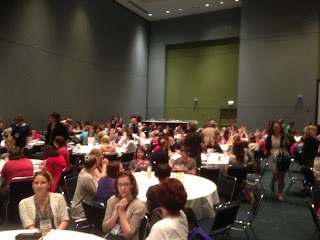
I made lots of new friends over the weekend - here's me with two fantastic graphic novelists: Gene Luen Yang and Faith Erin Hicks, both published by First Second Books.
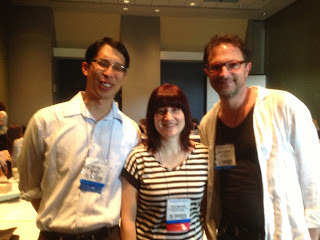
I also did a bookshop panel event in cute Naperville: here's the panel: (l-r) S A Bodeen, Sara Zarr, Annabel Pitcher (yay! a face from home :-) ) Tara Sullivan, and in the back is me with Matthew Quick of Silver Linings Playbook fame. He was a great speaker and said a couple of things that really resonated with me - that alone was worth the trip.
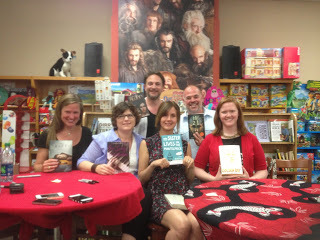
BTW, the dwarves behind in the background were nothing to do with us.
There was time for a few signings and dinners too, and the chance to talk books all day every day :-) All in all it was very good for the soul of the writer who spends so long in isolation to be immersed for a few days in such a wonderfully positive environment. Thanks to my US publishers, Roaring Brook, for giving me that chance.
Here's the view across the exhibition hall:

Yes, it's big. The other thing that strikes you immediately is how enthusiastic, knowledgable and passionate the delegates are. Whether they're from school or public libraries, I lost count of the great conversations I had with people over the importance of libraries, their changing role, and the sheer joy of helping children become more confident readers. In this respect, that's very like things are at home in the UK - we have passionate librarians too, but the sheer size of this conference and therefore the combined 'love in the room' is delightfully overwhelming.
I did a few events over the weekend. Here's a snapshot of the 'Coffee Klatsch' - which is basically like taking your book speed dating with 100 librarians. You have 4 minutes at a table of 6-10 delegates, then a whistle blows, and you move on to pitch your wares to the next table. Exhausting, intense and great fun.

I made lots of new friends over the weekend - here's me with two fantastic graphic novelists: Gene Luen Yang and Faith Erin Hicks, both published by First Second Books.

I also did a bookshop panel event in cute Naperville: here's the panel: (l-r) S A Bodeen, Sara Zarr, Annabel Pitcher (yay! a face from home :-) ) Tara Sullivan, and in the back is me with Matthew Quick of Silver Linings Playbook fame. He was a great speaker and said a couple of things that really resonated with me - that alone was worth the trip.

BTW, the dwarves behind in the background were nothing to do with us.
There was time for a few signings and dinners too, and the chance to talk books all day every day :-) All in all it was very good for the soul of the writer who spends so long in isolation to be immersed for a few days in such a wonderfully positive environment. Thanks to my US publishers, Roaring Brook, for giving me that chance.
Published on July 01, 2013 08:44
June 28, 2013
First Second :01
Today I did two things I never thought I'd do.
I'm on my way to Chicago for ALA 2013, but stopped over in New York for a couple of days to meet the people at First Second. First Second is an incredibly exciting graphic novel list, and I'm really pleased to say I'm about to sign a contract with them for a book written by me, and illustrated by my old friend, Thomas Taylor.
I headed down for lunch with Mark Siegel and Calista Brill. I'd only met Mark once briefly before and never met Calista except virtually, so it was a great chance today to discuss comics in general and in particular the one Thomas and I are going to make over the next couple of years.
Now the first thing to say about First Second is that, being part of the Macmillan US group, they work out of the coolest possible offices:

Yes, you're right, that is the Flatiron building.
Of course there are bigger, taller skyscrapers in Manhattan, but once upon a time, this was the tallest, and it's still the coolest, with the possible exception of the Chrysler. More than that, from a comics point of view, it's iconic; as Mark pointed out, this building is the home of the Daily Bugle in Spiderman. So it gets a few points for that.
Arriving at the lobby, I rode up in the (original) elevator to meet Mark and Calista who kindly found me when I was looking a little lost, and we headed out for lunch. It was here that I did the first unexpected thing today. We went to a great middle-Eastern place called Ilili, and Mark wondered if I'd like to try this:
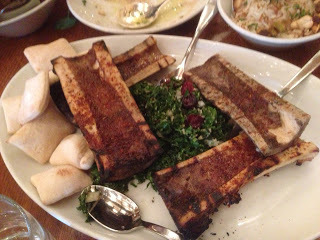
Yes, you're right, that is bone marrow.
We ate it, only afterwards wondering what it might have come from.
I digress. After a delicious lunch, we yakked about comics and discussed the project in hand - this is far too early to talk about it much, but it's called Scarlett Hart, and it looks like this:
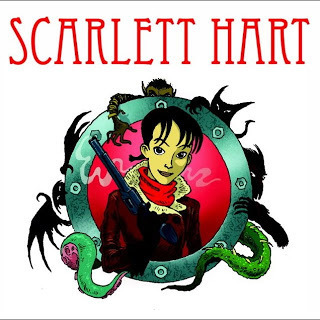
Yes, you're right, that is very cool. Which is not down to me but the superb skills of Thomas. I cannot wait to get cracking on this book properly, though that's going to be a while off yet.
Then, after lunch, we headed back to nose around Calista's office, which is very cool, since the walls are covered with very cool art (did I mention that these First Second guys are cool? Well they are).
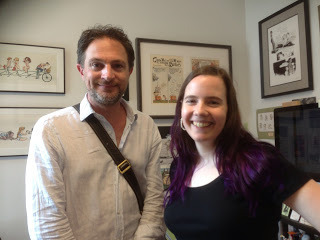
Yes, you're right, I do look like I've just eaten bone marrow. Calista, it turns out, once studied Finnish. Cool, no?
So then came the second thing I never thought I'd do:
Mark said: 'Do you want to go on the roof?'
Me: 'The roof? Of the Flatiron?'
Mark: 'Yes. The roof.'
Me: 'You're kidding..?'
He wasn't:

Here's Mark, by the way:
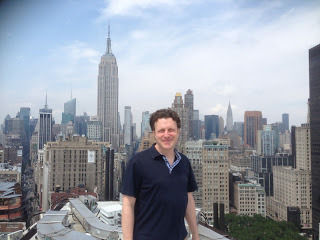
Mark is of course a superb creator of graphic novels himself: his extraordinary work Sailor Twain is testament to that.
I know the rooftop photos look a little fake, but it was a hazy afternoon and the whole of Manhattan was laid out like a film set. And really, at this point, any pretence that I might be as cool as these guys who make awesome graphic novels in an unbelievably iconic building went out of the window, as I stared around me like the slack-jawed yokel from a tiny village near Cambridge that I am.

Still, who needs to be cool?
If you don't know the great books that First Second make, have a look at their website - it's a great place to explore, and you get a real sense of what they're doing in that fantastic old building on 23rd Street.
I'm on my way to Chicago for ALA 2013, but stopped over in New York for a couple of days to meet the people at First Second. First Second is an incredibly exciting graphic novel list, and I'm really pleased to say I'm about to sign a contract with them for a book written by me, and illustrated by my old friend, Thomas Taylor.
I headed down for lunch with Mark Siegel and Calista Brill. I'd only met Mark once briefly before and never met Calista except virtually, so it was a great chance today to discuss comics in general and in particular the one Thomas and I are going to make over the next couple of years.
Now the first thing to say about First Second is that, being part of the Macmillan US group, they work out of the coolest possible offices:

Yes, you're right, that is the Flatiron building.
Of course there are bigger, taller skyscrapers in Manhattan, but once upon a time, this was the tallest, and it's still the coolest, with the possible exception of the Chrysler. More than that, from a comics point of view, it's iconic; as Mark pointed out, this building is the home of the Daily Bugle in Spiderman. So it gets a few points for that.
Arriving at the lobby, I rode up in the (original) elevator to meet Mark and Calista who kindly found me when I was looking a little lost, and we headed out for lunch. It was here that I did the first unexpected thing today. We went to a great middle-Eastern place called Ilili, and Mark wondered if I'd like to try this:

Yes, you're right, that is bone marrow.
We ate it, only afterwards wondering what it might have come from.
I digress. After a delicious lunch, we yakked about comics and discussed the project in hand - this is far too early to talk about it much, but it's called Scarlett Hart, and it looks like this:

Yes, you're right, that is very cool. Which is not down to me but the superb skills of Thomas. I cannot wait to get cracking on this book properly, though that's going to be a while off yet.
Then, after lunch, we headed back to nose around Calista's office, which is very cool, since the walls are covered with very cool art (did I mention that these First Second guys are cool? Well they are).

Yes, you're right, I do look like I've just eaten bone marrow. Calista, it turns out, once studied Finnish. Cool, no?
So then came the second thing I never thought I'd do:
Mark said: 'Do you want to go on the roof?'
Me: 'The roof? Of the Flatiron?'
Mark: 'Yes. The roof.'
Me: 'You're kidding..?'
He wasn't:

Here's Mark, by the way:

Mark is of course a superb creator of graphic novels himself: his extraordinary work Sailor Twain is testament to that.
I know the rooftop photos look a little fake, but it was a hazy afternoon and the whole of Manhattan was laid out like a film set. And really, at this point, any pretence that I might be as cool as these guys who make awesome graphic novels in an unbelievably iconic building went out of the window, as I stared around me like the slack-jawed yokel from a tiny village near Cambridge that I am.

Still, who needs to be cool?
If you don't know the great books that First Second make, have a look at their website - it's a great place to explore, and you get a real sense of what they're doing in that fantastic old building on 23rd Street.
Published on June 28, 2013 02:41
May 28, 2013
Working with my brother
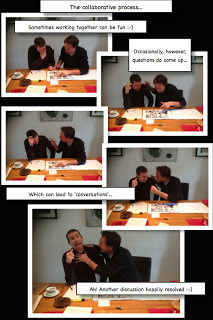 My brother, Julian, and I have been working together on two or three projects for a few years now. None of them have yet seen the harsh light of day but come October the first of these will be published: our graphic novel entitled Dark Satanic Mills.
My brother, Julian, and I have been working together on two or three projects for a few years now. None of them have yet seen the harsh light of day but come October the first of these will be published: our graphic novel entitled Dark Satanic Mills.By way of early celebration, we decided to each write and publish a blog post simultaneously, without reference to what the other brother was writing. This is my take; a link to Julian's is below...
We're still a few months away from publication as I write, yet already we are often asked what it's like to work with your brother.
Writing in collaboration is very different from working by yourself. I can't say I like it more or less than working on a book on your own; it has some advantages and it has some drawbacks. Overall I think it's an easier task in many ways - we often find that we leap ahead in the course of one conversation, getting to a place I suspect it would have taken me months to get to by myself. Another advantage is built-in editing - by discussing things aloud we often censure ideas that aren't up to scratch, are clichéd or are otherwise best left unwritten. Perhaps most importantly, when done well, I think the combination of two people's imaginations should be greater than the sum of the individuals; that something more weird and wonderful is sparked and brought to life through collaboration. I
The disadvantages? The main thing, for me, is exactly because you're living in a world of two people's creation. I think most writers would recognise that when you make a story, some part of your mind goes to live in the world that you're creating. It's an internal space and it's very intense at times. Emerging from one's writing cave, at the end of a day's work, can feel like you've been away for a long time on a distant journey. But when this world is no longer exclusively an internal space, that feeling is altered somewhat. Less intense. Maybe this doesn't matter if the end result is the same, or indeed better, than working on your own, and it's certainly less tiring working in collaboration. There's also someone else there to keep your nerve together at times when you're doubting yourself, and it also should be said that it's an awful lot of fun; as can be seen from the photo above; a day when we were doing some corrections to the page proofs of Dark Satanic Mills.
So that's collaboration; however, the added element with Julian and me is that we're brothers. I guess for many siblings this just wouldn't work, but for us, it does. We're very close, we always have been, and our childhood, growing up in a rather remote corner of the countryside, was largely one we created between us in a thousand games and flights of imagination. So we're used to that process, including the 'resolution of differences'... and there the main thing is that you respect the person you're working with; or their writing talents at least, and I respect my brother's skills enormously.
We're about to embark on a new collaborative book project, and I for one can't wait. I only hope my brother, over here, is typing the same thing...
Published on May 28, 2013 02:54
April 24, 2013
An incident that occurred in my shed this morning...
I record here verbatim an incident that occurred this morning as I was settling down to write.
My book: Back off, will you?
Me: Er, sorry, what..?
My book: I think you heard.
Me: Well, yes. Actually I did. And since you bring it up, I've been meaning, that is, I've been wanting to, er, have a word with you.
My book: A word?
Me: Yes.
Silence.
Me: Look, it's always difficult to say this kind of thing. But we've been together long enough now and we ought to be able to speak freely. You know, we've got a deadline coming up, and...
Silence.
Me: So, the thing is, I was just wondering, whether, I mean, that is I want to ask you if you could be a little bit less...tough. There, I've said it.
My book: Tough?
Me: Yes.
My book: Tough??
Me: Well, er, yes.
My book: What the xxxx do you mean by that?
Me: Now listen, I'm sure there's no need for that kind of language.
My book: Oh, you're sure about that, are you?
Me: I'd just be grateful if you could be a bit easier.
My book: Easier? Easier? You think this is easy?
Me: No, I don't! That's the point; it's hard enough as it is without you being really difficult.
My book: Difficult?
Me: Yes, difficult. To write.
My book: Oh here we go...
Me: You're just making things very hard.
My book: Yeah? Well it would help if you weren't such a pussy.
Me: I beg your pardon?
My book: You going deaf, or something? You are such a loser.
Me: Now just you...
My book: No! Don't do that to me. That's what you always do, isn't it? Always with the whining and the complaints. Why don't you just stop being so pathetic all the time, huh? Show some goddamn determination or something! Some backbone. Jeez! All I ever hear is "it's so hard" and "no one understands". Well try sitting here all day and listening to you bleating on. THAT'S hard, believe me, that's really hard. If writing me is so xxxxxxx hard then why don't you go and get a proper job?!
Me: A proper job.
My book: Yeah, like delivering the mail, or working the rigs. Or welding.
Me: Welding?
My book: Anything, just stop being so puny.
Me: Oh I see. You think I'm weak.
My book: Oh he sees. Oh he gets it. The light goddamn dawns. Well thank xxx for that. Yes! I think you're a xxxxxxxx xxxxx. I think you ought to just xxxx your xxxx and xxxx the xxx. See?
Me: Now just you stop that.
My book: Or you'll what? You gonna teach me a lesson, izzat it? Show me who's boss? You gonna take me out back and pop a cap in me? You gonna nail my xxx? Haw, haw, you make me wanna xxxx. You really do. You're nothing but a xxx. A xxxxxxx waste of a xxxxxxxxxxxx xxxx. I oughta xxxx your xxxx you xxx before I xxxxxxx xx xxxx and then xxx you xxxxx. Xxxx!
At that point I hit the delete key. But he knows as well as I do that I'll come crawling back. There's still that deadline, and he's still there, waiting for me, in the trash.
My book: Back off, will you?
Me: Er, sorry, what..?
My book: I think you heard.
Me: Well, yes. Actually I did. And since you bring it up, I've been meaning, that is, I've been wanting to, er, have a word with you.
My book: A word?
Me: Yes.
Silence.
Me: Look, it's always difficult to say this kind of thing. But we've been together long enough now and we ought to be able to speak freely. You know, we've got a deadline coming up, and...
Silence.
Me: So, the thing is, I was just wondering, whether, I mean, that is I want to ask you if you could be a little bit less...tough. There, I've said it.
My book: Tough?
Me: Yes.
My book: Tough??
Me: Well, er, yes.
My book: What the xxxx do you mean by that?
Me: Now listen, I'm sure there's no need for that kind of language.
My book: Oh, you're sure about that, are you?
Me: I'd just be grateful if you could be a bit easier.
My book: Easier? Easier? You think this is easy?
Me: No, I don't! That's the point; it's hard enough as it is without you being really difficult.
My book: Difficult?
Me: Yes, difficult. To write.
My book: Oh here we go...
Me: You're just making things very hard.
My book: Yeah? Well it would help if you weren't such a pussy.
Me: I beg your pardon?
My book: You going deaf, or something? You are such a loser.
Me: Now just you...
My book: No! Don't do that to me. That's what you always do, isn't it? Always with the whining and the complaints. Why don't you just stop being so pathetic all the time, huh? Show some goddamn determination or something! Some backbone. Jeez! All I ever hear is "it's so hard" and "no one understands". Well try sitting here all day and listening to you bleating on. THAT'S hard, believe me, that's really hard. If writing me is so xxxxxxx hard then why don't you go and get a proper job?!
Me: A proper job.
My book: Yeah, like delivering the mail, or working the rigs. Or welding.
Me: Welding?
My book: Anything, just stop being so puny.
Me: Oh I see. You think I'm weak.
My book: Oh he sees. Oh he gets it. The light goddamn dawns. Well thank xxx for that. Yes! I think you're a xxxxxxxx xxxxx. I think you ought to just xxxx your xxxx and xxxx the xxx. See?
Me: Now just you stop that.
My book: Or you'll what? You gonna teach me a lesson, izzat it? Show me who's boss? You gonna take me out back and pop a cap in me? You gonna nail my xxx? Haw, haw, you make me wanna xxxx. You really do. You're nothing but a xxx. A xxxxxxx waste of a xxxxxxxxxxxx xxxx. I oughta xxxx your xxxx you xxx before I xxxxxxx xx xxxx and then xxx you xxxxx. Xxxx!
At that point I hit the delete key. But he knows as well as I do that I'll come crawling back. There's still that deadline, and he's still there, waiting for me, in the trash.
Published on April 24, 2013 05:31
April 16, 2013
Maps
Here's a blog that's short on words but with lots of pictures.
Ever since I started writing books I have always made some kind of diagram or map to help me do it. Writing a book is hard and I do everything I can to make it easier. Making maps is just one of those things.
I've kept them all and thought I'd post a few here. They are all slightly different, because every book is, but however they look, they help me get my thoughts straight before and during the time that I put fingertips to the keyboard.
I've posted them here in reverse order - newer books first...
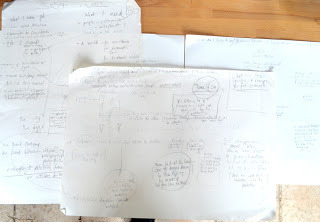 These are various maps for a version of a book that I aborted several times. The book's finally coming out this October in the UK, and is now called She Is Not Invisible.
These are various maps for a version of a book that I aborted several times. The book's finally coming out this October in the UK, and is now called She Is Not Invisible.
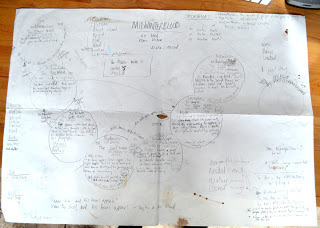 The simple map for Midwinterblood. That's raspberry juice at the bottom, by the way :-)
The simple map for Midwinterblood. That's raspberry juice at the bottom, by the way :-)
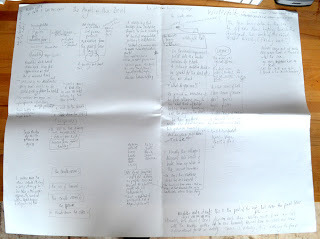 The map for White Crow - note the working title; titles often change.
The map for White Crow - note the working title; titles often change.
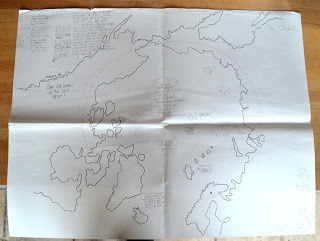 This is the map for Revolver, literally, for once, a map.
This is the map for Revolver, literally, for once, a map.
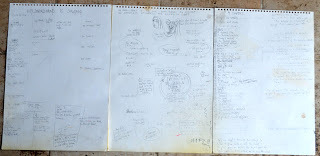 The three-pager for My Swordhand Is Singing
The three-pager for My Swordhand Is Singing
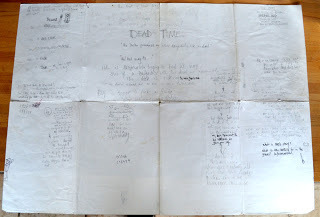 This is the first of three versions of a map for The Book of Dead Days
This is the first of three versions of a map for The Book of Dead Days
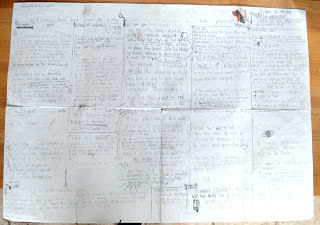 This is the third of three maps used for The Book of Dead Days
This is the third of three maps used for The Book of Dead Days
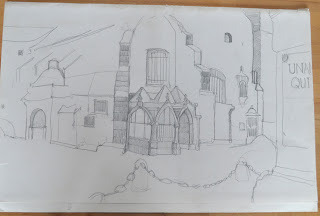 This is a sketch I did of 'The City' for The Book of Dead Days; I don't always do sketches but they sometimes help to bring the place to life in my head.
This is a sketch I did of 'The City' for The Book of Dead Days; I don't always do sketches but they sometimes help to bring the place to life in my head.
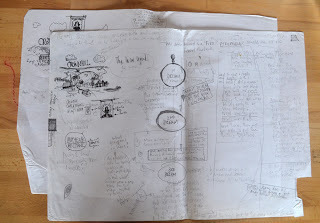 A couple of maps for Witch Hill
A couple of maps for Witch Hill
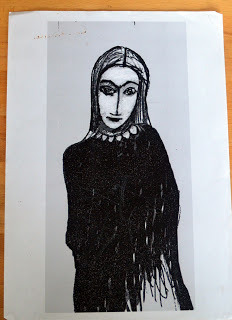 And a sketch of Alison, the accused girl in Witch Hill
And a sketch of Alison, the accused girl in Witch Hill
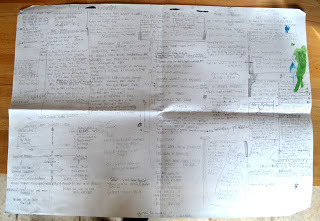 Finally: a curiosity - the map for the fourth of the four books I wrote before I got my first title published.
Finally: a curiosity - the map for the fourth of the four books I wrote before I got my first title published.
Ever since I started writing books I have always made some kind of diagram or map to help me do it. Writing a book is hard and I do everything I can to make it easier. Making maps is just one of those things.
I've kept them all and thought I'd post a few here. They are all slightly different, because every book is, but however they look, they help me get my thoughts straight before and during the time that I put fingertips to the keyboard.
I've posted them here in reverse order - newer books first...
 These are various maps for a version of a book that I aborted several times. The book's finally coming out this October in the UK, and is now called She Is Not Invisible.
These are various maps for a version of a book that I aborted several times. The book's finally coming out this October in the UK, and is now called She Is Not Invisible.
 The simple map for Midwinterblood. That's raspberry juice at the bottom, by the way :-)
The simple map for Midwinterblood. That's raspberry juice at the bottom, by the way :-)
 The map for White Crow - note the working title; titles often change.
The map for White Crow - note the working title; titles often change.
 This is the map for Revolver, literally, for once, a map.
This is the map for Revolver, literally, for once, a map.
 The three-pager for My Swordhand Is Singing
The three-pager for My Swordhand Is Singing
 This is the first of three versions of a map for The Book of Dead Days
This is the first of three versions of a map for The Book of Dead Days This is the third of three maps used for The Book of Dead Days
This is the third of three maps used for The Book of Dead Days This is a sketch I did of 'The City' for The Book of Dead Days; I don't always do sketches but they sometimes help to bring the place to life in my head.
This is a sketch I did of 'The City' for The Book of Dead Days; I don't always do sketches but they sometimes help to bring the place to life in my head. A couple of maps for Witch Hill
A couple of maps for Witch Hill
 And a sketch of Alison, the accused girl in Witch Hill
And a sketch of Alison, the accused girl in Witch Hill Finally: a curiosity - the map for the fourth of the four books I wrote before I got my first title published.
Finally: a curiosity - the map for the fourth of the four books I wrote before I got my first title published.
Published on April 16, 2013 09:09
March 31, 2013
Room 237 and what it tells us about author intention
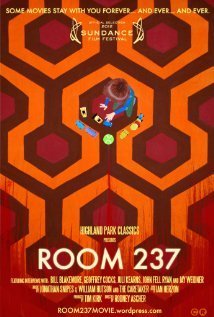 Last November, I think it was, we went to see the excellent documentary by Rodney Ascher, Room 237, at the ICA. I've been waiting since then for a DVD of the film to arrive because I immediately wanted to see it again.
Last November, I think it was, we went to see the excellent documentary by Rodney Ascher, Room 237, at the ICA. I've been waiting since then for a DVD of the film to arrive because I immediately wanted to see it again.It's a documentary that has quite rightly garnered a lot of praise - its subject is the hidden meanings of Stanley Kubrick's film version of Stephen King's The Shining - but the way it goes about discussing the film is unusual.
It features the voices (only) of five different commentators on what they think The Shining, or Kubrick's take on it, is actually about. No, it's not really about a writer getting cabin fever in a deserted hotel and trying to turn his wife and son into sushi with a fire axe.
According to the theories propounded in the movie, it's about various other things too: the Holocaust, the genocide of the Native American Indian, how NASA got Kubrick to fake the moon landings and then forced him into secrecy over the subject (!) and so on.
Instead of seeing the various commentators on screen, Room 237 uses a nice trick of using footage from various Kubrick films to play with, or against, the narrators of each theory, some of which turn out to be remarkably convincing, some, well, let's just say, some less so.
If you're interested in how these symbolisms play out, get hold of Room 237 and have a look, it's well worth it. What's most interesting about all this however is what it shows us about author intention.
A question I get frequently when visiting schools goes like this:
Student: 'You know when you write a book?'
Me: 'Uh-huh?'
Student (with one eye on their English teacher): 'Do you actually mean all those things our teacher says you mean?'
Me (smiling): 'Some of them.'
The (post) modern view holds that it doesn't actually matter whether the author meant that thing about the curtains:
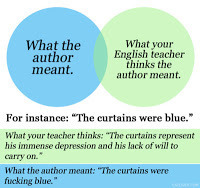 This cartoon is harsh on teachers: the intersection in the Venn diagram is much larger in general, I think.
This cartoon is harsh on teachers: the intersection in the Venn diagram is much larger in general, I think.What matters is what the reader took away from the text, whether or not the author meant to put that meaning there.
From my point of view, sometimes I've meant things to be in a text, and people have 'got it', sometimes they haven't. Sometimes, I haven't intended a particular meaning to be in a text, but people have found that meaning anyway. At which point, if it's cool, I immediately claim I meant it all along, and if it's fatuous, I deny all knowledge ;-)
Room 237 is wonderful because we see this process happening twice over. Stephen King wrote his book, and Kubrick made his film of it. So there's one instance of change in the 'text' already, and in this case, there are some significant changes between the book and the film; most of them improvements in my opinion: the book has giant topiary rabbits etc coming to 'life' in Jack's mind; the film has that frozen maze. The book ends with the over-signposted explosion of the hotel's boiler; the film ends in the maze in much more sinister fashion. King has Jack going ape with a Roquet mallet (huh?), Kubrick gets right to the point with a damn big axe. And so on. King famously hated what Kubrick did to his book, which Kubrick was well aware of. One of the narrators in Room 237 makes a nice point about how Jack's specifically red VW Beetle in the book becomes a yellow one in the movie, and then as if to put two fingers up to King, places a red Beetle under the wheels of a truck in the traffic accident scene; 'take that, author.'
And at this point, the wild theories about what Kubrick was actually trying to say with the film kick in - and fascinating it is to try to unpick where valid interpretation becomes ludicrous conspiracy theory, and perhaps the modern view is right, that if you find 'it', 'it's' real. But if that's so, just don't expect the author to put his hands up and admit to it too. He may well have meant nothing of the sort. Especially if you're the guy who believes Kubrick intended us to watch the movie backwards...
Published on March 31, 2013 08:48
March 4, 2013
Doctor Who and the Spear of Destiny
Here's a small clue to what I've been up to lately...
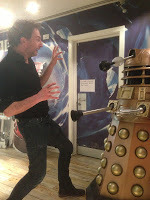 Yoinks! BBC TV Centre is more dangerous than I remembered!
Yoinks! BBC TV Centre is more dangerous than I remembered!
I'm absolutely delighted to announce that I've written the third in Puffin's year long celebration of Doctor Who's fiftieth anniversary. Each month from January to November each of the eleven Doctors is being brought to life once more by a different writer.
The news about each writer is being strictly embargoed which means that up until today, all anyone's been able to see about my book is this:
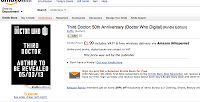 Ooh, who can it be? Eoin Colfer kicked off with the First Doctor back in January, and last month Michael Scott's Patrick Troughton-inspired Time Lord lived again.
Ooh, who can it be? Eoin Colfer kicked off with the First Doctor back in January, and last month Michael Scott's Patrick Troughton-inspired Time Lord lived again.
Now I've been given the chance to write a new story featuring my all-time favourite Doctor, Jon Pertwee. If you're not too familiar with classic Doctor Who (well, it is quite a long time ago now), then you might want to nip over here to find out a bit more about the Third Doctor.
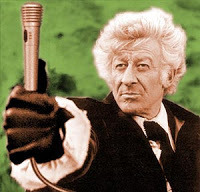 Jon PertweeI've never had to work so hard to keep my mouth shut.
Jon PertweeI've never had to work so hard to keep my mouth shut.
Now that I can finally talk about it, I can share a little my excitement at getting this chance. Doctor Who is iconic. There is no other word for it. It's now been a part of British culture for 50 years. 50! That's a lot. So I admit that when I finally sat down to write the opening words of my story, I had a sudden freeze. Hands poised over the keyboard, I thought "Holy -insert-your-own-expletive-here-, this is Doctor Who! Doctor Who!"
Then I gave myself a quick slap and got on with it, deciding to have as much fun as possible with the Third Doctor and Jo Grant in a jaunt into the Viking-age world. The picture above of me moments before annihilation by a Dalek is slightly misleading - for various reasons I decided to put the Doctor up against his old nemesis, the Master.
The story links together a few nice pieces of mythology and legend - the Spear of Destiny was the spear which pierced Christ's side as he hung on the cross. Legend has it that the armies of whoever holds the spear would be invincible. It was of the various supernatural things that Hitler was obsessed with. But as it happens, someone else who hung on a piece of wood was Odin. He hung on the 'world tree' for nine days and nights, and was pierced by his own spear, a magical weapon called Gungnir. Here's a picture of Odin in happier times, resting on his throne with his faithful ravens, Huginn and Muninn, alongside.
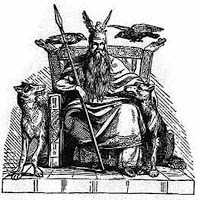 Odin with GungnirThere are more of these nice serendipitous connections in the story, but I don't want to give away too much more about the plot for now.
Odin with GungnirThere are more of these nice serendipitous connections in the story, but I don't want to give away too much more about the plot for now.
Instead, I'll just say that I hope people like it. Doctor Who is, after all, one of those things that has a very large and very faithful fanbase, of whom I was very aware when writing. I tried my best to bring the wonderful Jon Pertwee back to life for a short time, and if a few of those fans agree, I'll be more than happy.
For now the story is only available as an ebook, and you know what that means: go here to see it.
 Yoinks! BBC TV Centre is more dangerous than I remembered!
Yoinks! BBC TV Centre is more dangerous than I remembered!I'm absolutely delighted to announce that I've written the third in Puffin's year long celebration of Doctor Who's fiftieth anniversary. Each month from January to November each of the eleven Doctors is being brought to life once more by a different writer.
The news about each writer is being strictly embargoed which means that up until today, all anyone's been able to see about my book is this:
 Ooh, who can it be? Eoin Colfer kicked off with the First Doctor back in January, and last month Michael Scott's Patrick Troughton-inspired Time Lord lived again.
Ooh, who can it be? Eoin Colfer kicked off with the First Doctor back in January, and last month Michael Scott's Patrick Troughton-inspired Time Lord lived again.Now I've been given the chance to write a new story featuring my all-time favourite Doctor, Jon Pertwee. If you're not too familiar with classic Doctor Who (well, it is quite a long time ago now), then you might want to nip over here to find out a bit more about the Third Doctor.
 Jon PertweeI've never had to work so hard to keep my mouth shut.
Jon PertweeI've never had to work so hard to keep my mouth shut.Now that I can finally talk about it, I can share a little my excitement at getting this chance. Doctor Who is iconic. There is no other word for it. It's now been a part of British culture for 50 years. 50! That's a lot. So I admit that when I finally sat down to write the opening words of my story, I had a sudden freeze. Hands poised over the keyboard, I thought "Holy -insert-your-own-expletive-here-, this is Doctor Who! Doctor Who!"
Then I gave myself a quick slap and got on with it, deciding to have as much fun as possible with the Third Doctor and Jo Grant in a jaunt into the Viking-age world. The picture above of me moments before annihilation by a Dalek is slightly misleading - for various reasons I decided to put the Doctor up against his old nemesis, the Master.
The story links together a few nice pieces of mythology and legend - the Spear of Destiny was the spear which pierced Christ's side as he hung on the cross. Legend has it that the armies of whoever holds the spear would be invincible. It was of the various supernatural things that Hitler was obsessed with. But as it happens, someone else who hung on a piece of wood was Odin. He hung on the 'world tree' for nine days and nights, and was pierced by his own spear, a magical weapon called Gungnir. Here's a picture of Odin in happier times, resting on his throne with his faithful ravens, Huginn and Muninn, alongside.
 Odin with GungnirThere are more of these nice serendipitous connections in the story, but I don't want to give away too much more about the plot for now.
Odin with GungnirThere are more of these nice serendipitous connections in the story, but I don't want to give away too much more about the plot for now.Instead, I'll just say that I hope people like it. Doctor Who is, after all, one of those things that has a very large and very faithful fanbase, of whom I was very aware when writing. I tried my best to bring the wonderful Jon Pertwee back to life for a short time, and if a few of those fans agree, I'll be more than happy.
For now the story is only available as an ebook, and you know what that means: go here to see it.
Published on March 04, 2013 23:33
February 12, 2013
Icebergs, and What I've Been Doing
It hasn't escaped everyone's notice that I didn't put out a new YA novel in 2012, and in that time the question has been levelled at me from time to time; what are you doing?
Well, I haven't been twiddling my thumbs, not all the time anyway. I've been working on the Elf Girl and Raven Boy series, and on that graphic novel I'm doing with my brother, and on a screenplay with him too, and on a play version of My Swordhand is Singing, and all of these things are taking slow steps forward into the world, but they take a loooong time to actually arrive. So to the outside world it looks like I've been slacking :-(
And I did want to write a new YA novel, only the problem was, I couldn't think of one. Did I have writer's block? Maybe I did, but despite two years of failing to get a book written, I'm still not sure if it actually exists. That must sound pretty stupid, and I can't really explain what I mean. Only that I had ideas during this time, but something about them wasn't happening. They didn't develop properly, despite the fact that I tried everything I know to make them do so. I tried smothering them with attention, and I tried ignoring them, and everything in between, but nothing worked.
In increasing desperation I read everything and anything I could on creative blocks, spoke to every sympathetic author I could (thanks, people:-) ) and generally tried to figure out what was wrong. Everyone I spoke to, without fail, told me that the ideas would come back and that I'd know what to write again soon, but I'd managed to spook myself thoroughly by reading about various composers and writers who just stopped creating one day, and never took it up again. In the case of Sibelius, that was the last thirty years of his life. In the case of Rossini, most of the last forty. That scared the hell out of me, and anyway, the problem wasn't that I wasn't having ideas, but that they weren't growing like they should.
Never the most frequent of bloggers, my entries fell away to nothing, simply because I felt like fraud talking about writing when I wasn't doing it.
And then an iceberg sailed over the horizon. What I mean by this is that an idea that I've been thinking about, on and off, for seven years, finally decided to let me get a hold of it. I finally knew how to write it, having started once five years ago and having abandoned it. This time I knew it was going to be all right, and so now I'm very glad to say I've just finished the second draft of my next YA book, due out in October. Phew. It's called She Is Not Invisible.
Why's it an iceberg? Because the book has ended up being relatively short, at around 45,000 words. But there is more thinking and more planning and more research under the visible surface of this novel than anything I've ever done before. But of course, only the top 10% can be seen. I think Hemingway said something like that about all his writing, and you can be sure he said it better than me, with much more grandeur, and with a drink in his hand, too ;-)
Well, I haven't been twiddling my thumbs, not all the time anyway. I've been working on the Elf Girl and Raven Boy series, and on that graphic novel I'm doing with my brother, and on a screenplay with him too, and on a play version of My Swordhand is Singing, and all of these things are taking slow steps forward into the world, but they take a loooong time to actually arrive. So to the outside world it looks like I've been slacking :-(
And I did want to write a new YA novel, only the problem was, I couldn't think of one. Did I have writer's block? Maybe I did, but despite two years of failing to get a book written, I'm still not sure if it actually exists. That must sound pretty stupid, and I can't really explain what I mean. Only that I had ideas during this time, but something about them wasn't happening. They didn't develop properly, despite the fact that I tried everything I know to make them do so. I tried smothering them with attention, and I tried ignoring them, and everything in between, but nothing worked.
In increasing desperation I read everything and anything I could on creative blocks, spoke to every sympathetic author I could (thanks, people:-) ) and generally tried to figure out what was wrong. Everyone I spoke to, without fail, told me that the ideas would come back and that I'd know what to write again soon, but I'd managed to spook myself thoroughly by reading about various composers and writers who just stopped creating one day, and never took it up again. In the case of Sibelius, that was the last thirty years of his life. In the case of Rossini, most of the last forty. That scared the hell out of me, and anyway, the problem wasn't that I wasn't having ideas, but that they weren't growing like they should.
Never the most frequent of bloggers, my entries fell away to nothing, simply because I felt like fraud talking about writing when I wasn't doing it.
And then an iceberg sailed over the horizon. What I mean by this is that an idea that I've been thinking about, on and off, for seven years, finally decided to let me get a hold of it. I finally knew how to write it, having started once five years ago and having abandoned it. This time I knew it was going to be all right, and so now I'm very glad to say I've just finished the second draft of my next YA book, due out in October. Phew. It's called She Is Not Invisible.
Why's it an iceberg? Because the book has ended up being relatively short, at around 45,000 words. But there is more thinking and more planning and more research under the visible surface of this novel than anything I've ever done before. But of course, only the top 10% can be seen. I think Hemingway said something like that about all his writing, and you can be sure he said it better than me, with much more grandeur, and with a drink in his hand, too ;-)
Published on February 12, 2013 08:28
January 31, 2013
Judgement
On Tuesday I finished my work as one of this year's judges for the Costa Book Awards; I was a category judge for the children's prize, and then joined the final panel to select the overall winner.
Here, before I get into the point of this post, is a photo of that final judging panel which I present here as evidence that writers can dress smartly when required to do so.
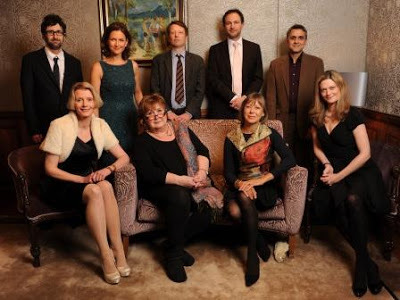 Left to right:
Left to right:
Mark Watson, Katie Derham, D.J. Taylor, me, Daljit Nagra,
Wendy Holden, Jenni Murray, Jenny Agutter, Sophie Ward
Everyone knows that it's a really hard thing to decide not just between five books on a shortlist, but five different kinds of book, something that is unique to the Costa Book Awards, as far as I'm aware. To compare a children's book with a poetry collection, a biography, a novel and a first novel is pretty tough. What is the 'best' book, when the books are so very different in their nature in the first place?
The final truth of the matter however, is this: choosing any winner of a prize is a somewhat arbitrary decision. Yes, there are books that most people would consider bad, and books that many people would consider good, but once you get to the upper end of the scale, what makes one book 'better' than another? At this point, all the arguments about style and skill and emotion and structure and language start to break down, because they are ALL good books. And what you're left with at that point is no more than a feeling. Which book lived with you the longest, which affected you the most? That to me is as good a way of judging a prize as anything else, and therein lies the point - these are very much personal feelings, which may be shared by another judge, but which may well not be.
Having sat on around half a dozen judging panels now, I've had some experiences I would rather not repeat, and I've had some that were delightful, as was the case this week I'm glad to say. But one thing I have learned is this: if your book is shortlisted for an award, and you don't win, don't be too upset. How the book that 'beat' yours was chosen may not be as clear-cut as people imagine.
And there's a inverse to that law - if you did win, don't get too cocky. Don't stand on the stage and KNOW your book was better than everything else published that year. The judges may know there was a little more, or rather less, to it than that.
Here, before I get into the point of this post, is a photo of that final judging panel which I present here as evidence that writers can dress smartly when required to do so.
 Left to right:
Left to right:Mark Watson, Katie Derham, D.J. Taylor, me, Daljit Nagra,
Wendy Holden, Jenni Murray, Jenny Agutter, Sophie Ward
Everyone knows that it's a really hard thing to decide not just between five books on a shortlist, but five different kinds of book, something that is unique to the Costa Book Awards, as far as I'm aware. To compare a children's book with a poetry collection, a biography, a novel and a first novel is pretty tough. What is the 'best' book, when the books are so very different in their nature in the first place?
The final truth of the matter however, is this: choosing any winner of a prize is a somewhat arbitrary decision. Yes, there are books that most people would consider bad, and books that many people would consider good, but once you get to the upper end of the scale, what makes one book 'better' than another? At this point, all the arguments about style and skill and emotion and structure and language start to break down, because they are ALL good books. And what you're left with at that point is no more than a feeling. Which book lived with you the longest, which affected you the most? That to me is as good a way of judging a prize as anything else, and therein lies the point - these are very much personal feelings, which may be shared by another judge, but which may well not be.
Having sat on around half a dozen judging panels now, I've had some experiences I would rather not repeat, and I've had some that were delightful, as was the case this week I'm glad to say. But one thing I have learned is this: if your book is shortlisted for an award, and you don't win, don't be too upset. How the book that 'beat' yours was chosen may not be as clear-cut as people imagine.
And there's a inverse to that law - if you did win, don't get too cocky. Don't stand on the stage and KNOW your book was better than everything else published that year. The judges may know there was a little more, or rather less, to it than that.
Published on January 31, 2013 08:15
Marcus Sedgwick's Blog
- Marcus Sedgwick's profile
- 1579 followers
Marcus Sedgwick isn't a Goodreads Author
(yet),
but they
do have a blog,
so here are some recent posts imported from
their feed.



